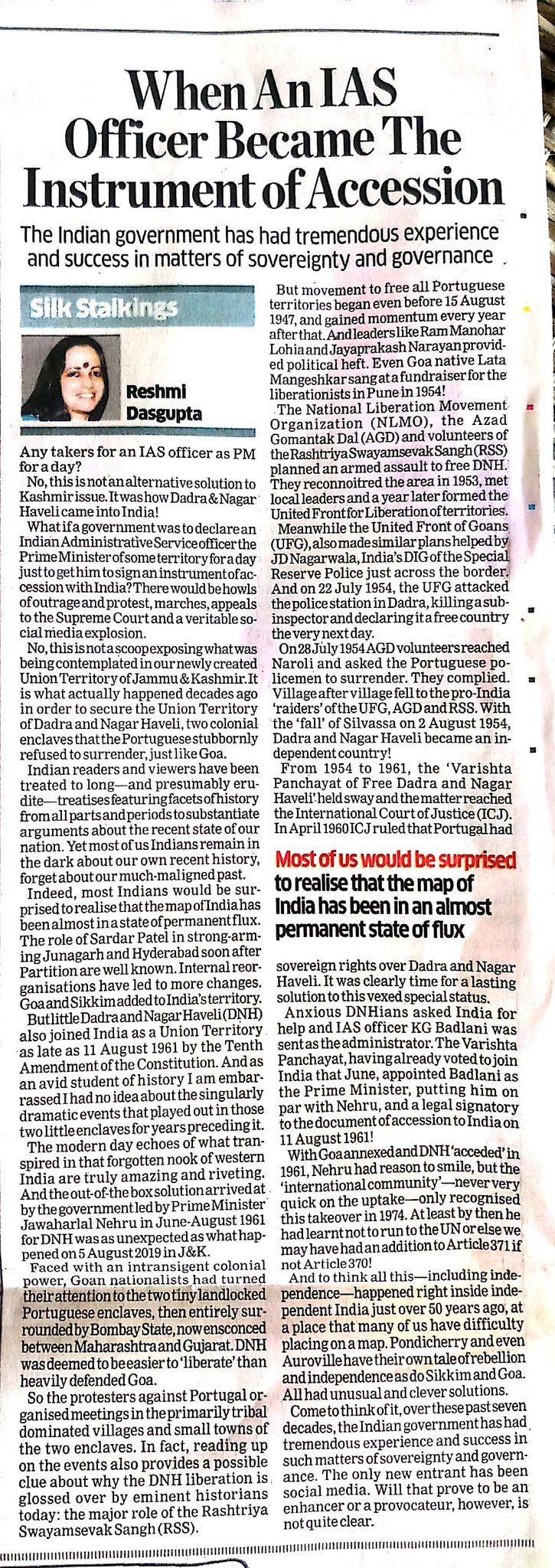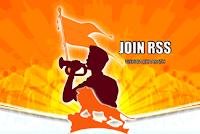 |
| The story of a forgotten freedom struggle, Dadra and Nagar Haveli, images via Jagran and NIE |
On August 11, 1961, in a unique and intriguing move, KG Badlani was appointed as the Prime Minister of Dadra and Nagar Haveli. By making him Prime Minister, Badlani was made 'equal to Nehru', with the power to sign the document of accession with India.
When the British finally decided to leave India and hand over the governing power to Indians, the subcontinent was divided into dozens of princely states, and some scattered territories under the rule of the Portuguese and French. The collation of all the areas into the Union of India was an arduous and extensive task that took time and a lot of efforts.
We all know how Sardar Ballabhbhai Patel, by his sheer will and determination, had made the princely states of Junagarh, and Hyderabad give up the designs of their Muslim rulers to join Pakistan and instead become the part of India.
Some parts of India, like Goa, Pondicherry and others became official Indian territories a little later than 1947. Sikkim too came later. The little Union Territory we know as Dadra and Nagar Haveli today also became a part of India quite late because it was under Portuguese control and they were not willing to let it go.
 |
| The story of the accession of the coastal Union Territory with India is an interesting one. |
Located just between the states of Gujarat and Maharashtra, and just over 150 km from Mumbai, is the Union Territory of Dadra and Nagar Haveli. In January 2020, the two UTs of Dadra & Nagar Haveli and Daman & Diu were merged into one.
History
The coastal territories of Dadra and Nagar Haveli came under Portuguese control in 1783 and 1785 respectively. It was an enclave of around 72 villages. The total area is approximately 491 square km. Before the Portuguese control, the area was historically under Koli chieftains, and Rajputs, eventually controlled by Marathas.
Under the Maratha rule, the Portuguese were later granted permission to collect revenues from the villages of Nagar Haveli after a treaty. After the Maratha powers were defeated in the third Anglo-Maratha war in 1818, the Portuguese took control of the area and recognised it as territory of Portuguese India.
Call for liberation and armed resistance against Portuguese rule
In the 1930s, when the anti-Portuguese movement in Goa started gaining momentum, it also caused similar movements in Dadra and Nagar Haveli. Many freedom fighters were active under different organisations, demanding the Portuguese to hand over the area. Appasaheb Karmalkar, a government employee who was heading the National Liberation Movement Organisation (NMLO), the Azad Gomantak Dal led by Vishwanath Lavande, Prabhakar Sinari, Dattatreya Deshpande were the leaders who were spearheading the movement for the liberation of Portuguese-controlled territories in India.
The volunteers of Rashtriya Swayamsevak Sangh (RSS) played a crucial role in the liberation movement. RSS leaders Raja Wakankar and Nana Kajrekar had made several tours to the area, taking stock of the situation and organising the locals against a revolution against the Portuguese. The RSS, along with the other liberation movement organisations, was planning for an armed assault against the Portuguese at Dadra and Nagar Haveli.
Many leaders, including Lohia and Jay Prakash Narayan etc, had supported the liberation of Dadra and Nagar Haveli. Even the legendary singer Lata Mangeshkar had performed in Pune in 1954 at an event to raise funds for the cause.
In 1954, RSS, NLMO and AGD formed a United Front to lead an armed assault against the Portuguese officials at Dadra and Nagar Haveli. The entry of persons and material to Dadra and Nagar Haveli was under the control of the Special Reserve Police of the government of India. JD Nagarwala, the DIG of the SRP was also sympathetic to the cause of the liberation of Dadra and Nagar Haveli. Another organisation called the United Front of Goans was also working to force the Portuguese out of the area.
The UFG had attacked the Dadra police station and overpowered the staff to unfurl the Indian flag on July 22, 1954. Dadra was declared a free territory. On 28 July, RSS swayamsevaks under Wakankar and AGD volunteers stormed the Naroly police station and overpowered the Portuguese staffers, forcing them to surrender. Naroly was declared free from Portuguese rule the next day. Communist Party was also leading the tribals of several villages to protest against the Portuguese rule.
As liberation forces gained momentum, the Portuguese forces retreated to Silvassa, under Captain Virgilio Fidalgo. The liberation forces asked Fidalgo to surrender. When he did not, hundreds of RSS swayamsevaks and AGD workers marched towards Silvassa. The Portuguese fled, and the RSS and other organisations declared Dadra and Nagar Haveli independent of Portuguese rule on August 2, 1954.
The liberation forces continued to track and attack the Portuguese. Finally, Fidalgo surrendered to the SRP on August 11. Appasaheb Karmalkar was chosen as the first administrator of Dadra and Nagar Haveli at a public meeting later.
Integration: The one-day Prime Minister
Even though Dadra and Nagar Haveli was declared independent from Portuguese rule in 1954, it was many years before the area was formally added as a part of the Indian Union. In legal terms, after the fall of the Portuguese rule on August 2, 1954, Dadra and Nagar Haveli had become an independent country. The freedom organisations formed a governing body called the Varishtha Panchayat of Free Dadra and Nagar Haveli. The story of the integration was narrated in a 2019 Economic Times article.
 |
| Locals celebrating with the Indian flag in Dadra and Nagar Haveli, image via The Better India |
However, the government of Portugal was not ready to give up. They took the matter to the International Court of Justice. An article in the Economic Times suggests, in 1960, the ICJ ruled in favour of Portugal, saying that they have sovereign rights over Dadra and Nagar Haveli. The Varishtha Panchayat then knew that it was time for some drastic action.
The local leaders and the Varishtha Panchayat reached out to the government of India. A Gujarat cadre senior IAS officer named KG Badlani was then sent as an administrator. In June 1961, the people of Dadra and Nagar Haveli and the Varishtha Panchayat had voted to join India.
On August 11, 1961, in a unique and intriguing move, KG Badlani was appointed as the Prime Minister of Dadra and Nagar Haveli. By making him Prime Minister, Badlani was made ‘equal to Nehru’, with the power to sign the document of accession with India. And with that manoeuvre, the document was signed, a constitutional amendment was made in the Parliament and Dadra and Nagar Haveli was officially recognised as a Union Territory of India.
Soon after the accession of Dadra and Nagar Haveli, the Portuguese were driven out of Goa too. After the Portuguese forces attacked Indian ships in November 1961, Indian armed forces stormed into Goa to a rousing welcome by Goans in December and the Portuguese were made to give the region up.
The case of Dadra and Nagar Haveli was unique due to many reasons. Armed Swayamsevaks had marched into the region to fight with the Portuguese. Also, unlike Kashmir, thankfully, Nehru did not take the issue to the UN.
Though India formally added Dadra and Nagar Haveli as a Union Territory in 1961, the international community had not recognised the region as a part of India till 1974. The story of the liberation of Dadra and Nagar Haveli and the events after, when an IAS officer was made a PM for one day, is one of the many intriguing tales of the formation of the strong sovereign republic that we are today. Our map has seen many changes over the decades and it has taken a lot of hard work and sacrifices by countless individuals to become what we are today.
Inputs ..Opindia





















